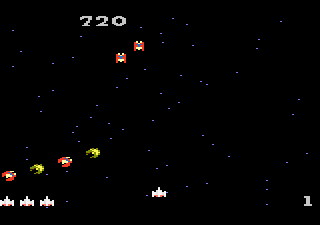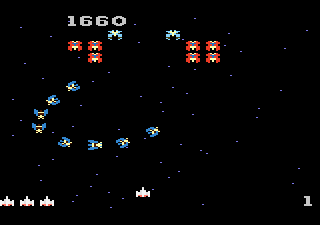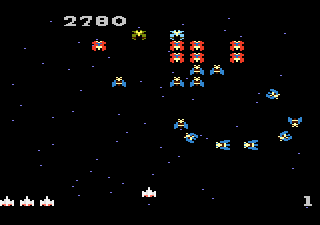|
|
Galaga
|
Name:
|
Galaga |
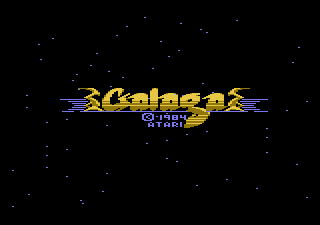 |
| Company: | Atari | |
|
Model #:
|
CX-7805 | |
|
Programmer:
|
Dave Krall, David Chan, and Mustafa (GCC) | |
| Year: | 1984 | |
|
Released?
|
Yes
|
|
|
Notes:
|
Port of the 1981 Namco Coin-Op |
Although it may not be immediately apparent, Galaga is actually the sequel to Galaxian. While Galaxian may have been a breakthrough in space shooters, it never achieved the same popularity that Galaga did. This is probably because Galaga took everything that Galaxian did right, and improved it.
Galaga improved over Galaxian in several important areas. The most famous of these improvements was the ability for the players ship to be captured by the boss Galaga. Every now and then the boss will send out a blue beam (oddly rainbow colored in the 7800 version) which if touched will capture the players ship. Once captured your ship will fight along side the Galagas until the boss controlling it is destroyed. Once the boss is destroyed the capture ship joins together with your current ship, allowing the player to have double the firepower (with the added determent of increased ship size). Most players will allow their ship to get captured on purpose in order to get the double firepower upgrade.
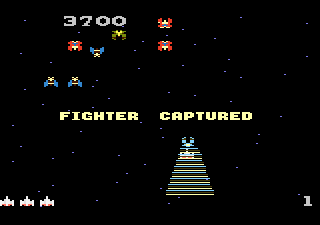
Other enhancements include enemies that take multiple hits, bonus enemies, enemies that fly in at the start of the round, and the ever popular bonus round simply known as the "Challenging Stage". During these bonus rounds waves of enemies will fly around the screen in distinct patterns without firing, allowing the player (assuming they know the patterns) to easily shoot them for massive amounts of bonus points.
The 7800 version's graphics are very nice, but somehow everything looks less sharp than the arcade version. This may be because of the funky Atari 7800 color pallet which seemed to produce more pastel looking colors than the arcade machines of the time. The Atari 7800 version also seems to have major trouble with slow down. This may not be readily apparent at the lower levels, but once the speed increases on level ten, the slow down becomes almost intolerable. The sound is also sub par, but this is a common problem with 7800 games that didn't utilize a built in Pokey chip on the cartridge.
Other than the debilitating slow down that plagues the game past level ten, Galaga is a fairly good port of the uber popular arcade game. A version of Galaga was also released for the NES which not only looked better, but didn't have any slow down problems (although there was some flickering). Perhaps if Galaga had under gone a little more fine tuning, it could have been the 7800's 'killer app', rather than a 'could have been'.
| Version | Cart Text | Description |
| ?/??/84 | Galaga | Final version |

